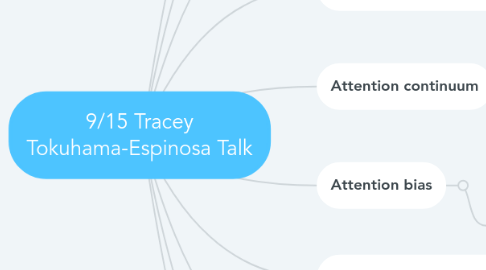9/15 Tracey Tokuhama-Espinosa Talk
por Tyler Vazquez


1. Mind Wandering
1.1. Mind Wandering is when you let your mind traverse all thoughts while not being bound or effected by the environment.
1.1.1. (Sub Point) In turn, you formulate your own thoughts, draw connections, and develop your own ideas without it being related to what is going on around you.
2. Heuristics
2.1. Tracey Tokuhama-Espinosa touched upon the idea of Heuristics saying, that this is a more conventional and effective way of learning rather than traditional methods still being used today.
2.1.1. (Sub Point) Heuristics enable one to learn something for themselves using more practical methods.
3. Attention as saliency from a perception perspective
3.1. Attention saliency is when the mind distinguishes something from the things around it due to its unique features and characteristics.
4. Selective attention: Bottleneck
4.1. According to Tracey Tokuhama-Espinosa, this theory revolves around the idea of only having so many attentional resources, that if overwhelmed, it's nearly impossible to remain focused.
5. Attention continuum
5.1. Tracey used an example while trying to elaborate on what this idea is. She revealed how emotions can move sequentially like going from being bored, to high alert, then to high stress.
6. Attention bias
6.1. When it comes to teaching, students can easily become bias as to where they focus their attention on. In doing so, this can negatively impact the student's way of learning.
6.1.1. (Sub Point) To combat this, teachers must keep all of their students engaged so they don't veer off from what important things are being taught.
7. Attention Deficit Disorder
7.1. As known to many, this disorder appears in mostly males that interferes with their attention span, brain function, and brain development.
8. Attention Span
8.1. One's attention span is how long one can be fixated on one thing without taking their focus off of whatever task is at hand.
8.1.1. (Sub Point) Typically, people with ADD/ADHD have terrible attention spans, only being able to focus on things until they become easily distracted by an external force.
9. Attentional networks
9.1. Attentional networks are located throughout the brain giving people to the ability to maintain their sensory input and other brain functions pertaining to attention.
10. No learning without both attention and memory
10.1. Tracey Tokuhama-Espinosa stated that one cannot learn with only being attentive, or only having good memory.
10.1.1. (Sub Point) Both must coincide with each other in order to successfully learn.
